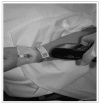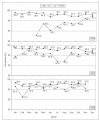Improved traceability and transfusion safety with a new portable computerised system in a hospital with intermediate transfusion activity
- PMID: 21251464
- PMCID: PMC3096861
- DOI: 10.2450/2011.0044-10
Improved traceability and transfusion safety with a new portable computerised system in a hospital with intermediate transfusion activity
Abstract
Background: A retrospective study carried out on medical records of transfused patients in our hospital in 2002 revealed that manual identification procedures were insufficient to offer satisfactory traceability. The aim of this study was to assess adequacy of transfusion traceability and compliance with proper identification procedures after introducing an electronic identification system (EIS) for transfusion safety.
Materials and methods: The chosen EIS (Gricode(®)) was set up. Traceability was calculated as the percentage of empty blood units used returned to the Transfusion Service, compared to the number of supplied units. Compliance in the Transfusion Service was calculated as the percentage of electronic controls from dispatch of blood components/transfusion request performed, compared to the total number of transfused units. Compliance in the ward was calculated as the percentage of electronic controls from sample collection/transfusion performed, compared to the total number of samples collected.
Results: This retrospective study showed that only 48.0% of the medical records were free of inaccuracies. After the implementation of the EIS (2005-2008), traceability was always above 99%. Percentage of monthly compliance from 2006 to 2008 was always above 93%, showing a significant trend to increase (p<0.05). The mean compliance in this period was higher in the Transfusion Service (97.8 ± 0.7 SD) than in the ward (94.9 ± 2.4 SD; p<0.001). Compliance in the ward was lowest when the system was first implemented (87.9% in April 2006) after which it progressively increased. No errors in ABO transfusions were registered.
Conclusion: After implementation of the EIS, traceability and compliance reached very high levels, linked to an improvement in transfusion safety.
Figures






References
-
- Linden JV. Errors in transfusion medicine. Scope of the problem. Arch Pathol Lab Med. 1999;123:563–5. - PubMed
-
- Stainsby D, Russell J, Cohen H, Lilleyman J. Reducing adverse events in blood transfusion. Br J Haematol. 2005;131:8–12. - PubMed
-
- Callum JL, Kaplan HS, Merkley LL, et al. Reporting of near-miss events for transfusion medicine: improving transfusion safety. Transfusion. 2001;41:1204–11. - PubMed
-
- Lau FY, Cheng G. To err is human nature. Can transfusion errors due to human factors ever be eliminated? Clin Chim Acta. 2001;313:59–67. - PubMed
-
- Dzik WH. Technology for enhanced transfusion safety. Hematology Am Soc Hematol Educ Program. 2005:476–82. - PubMed
Publication types
MeSH terms
LinkOut - more resources
Full Text Sources
Medical
Miscellaneous
